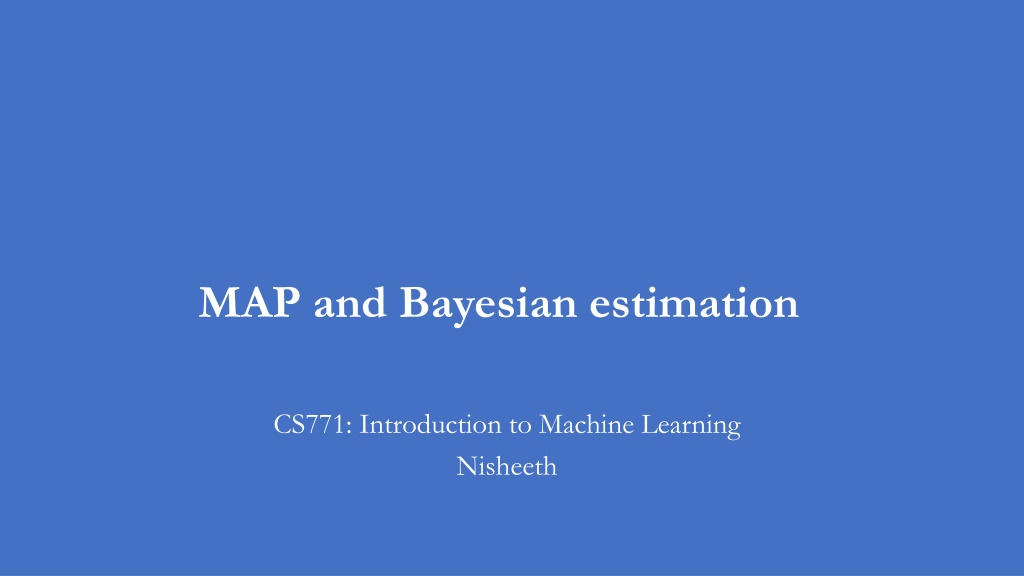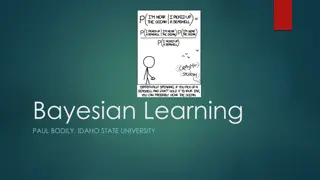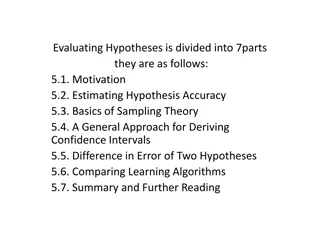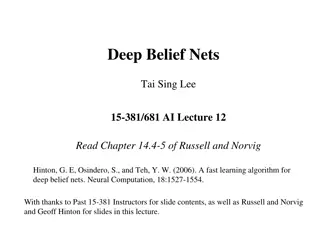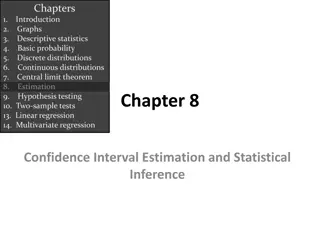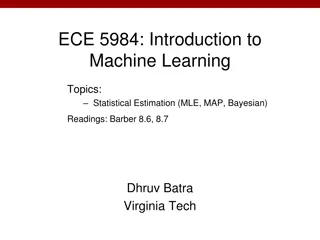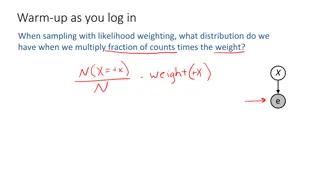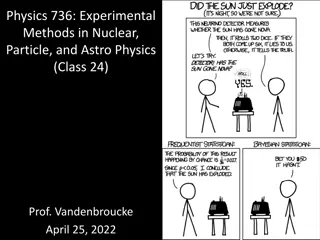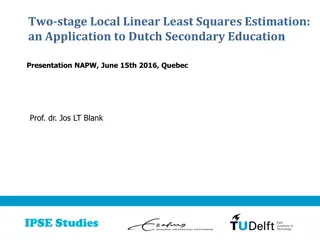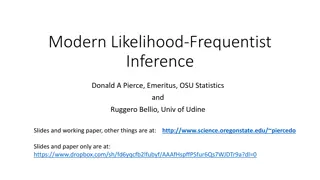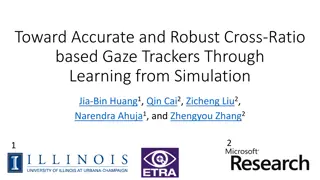Understanding Maximum Likelihood Estimation in Machine Learning
In the realm of machine learning, Maximum Likelihood Estimation (MLE) plays a crucial role in estimating parameters by maximizing the likelihood of observed data. This process involves optimizing log-likelihood functions for better numerical stability and efficiency. MLE aims to find parameters that make the observed data statistically most probable. Despite its effectiveness, MLE has shortcomings, such as overfitting, which can be addressed through regularization techniques. This summary introduces key concepts and challenges associated with MLE in the context of machine learning.
Uploaded on Nov 17, 2024 | 0 Views
Download Presentation

Please find below an Image/Link to download the presentation.
The content on the website is provided AS IS for your information and personal use only. It may not be sold, licensed, or shared on other websites without obtaining consent from the author. Download presentation by click this link. If you encounter any issues during the download, it is possible that the publisher has removed the file from their server.
E N D
Presentation Transcript
MAP and Bayesian estimation CS771: Introduction to Machine Learning Nisheeth
Quick announcements Your mid-sem exam is being graded Marks will likely be released by the end of this week Assignment 2 is due at the end of this week CS771: Intro to ML
3 MLE recap The goal in MLE is to find the optimal ? by maximizing the likelihood In practice, we maximize the log of the likelihood (log-likelihood in short) Leads to simpler algebra/calculus, and also yields better numerical stability when implementing it om computer (dealing with log of probabilities) Taking log doesn t affect the optima since log is a monotonic function log ? ?|? ? ?? ? = log? ?|? = log ?(??|?) ?=1 ? ????= ???? ? = log ? ??? ?=1 Thus the MLE problem is ????= argmax ? ?? ? = argmax ?=1 log ? ??? ? ? This is now an optimization (maximization problem). Note: ? may have constraints CS771: Intro to ML
4 MLE Recap Negative Log-Likelihood (NLL) The MLE problem can also be easily written as a minimization problem ? ? log ? ??? = argmin ?=1 ?=1 ????= argmax log ? ??? ? ? Thus MLE can also be seen as minimizing the negative log-likelihood (NLL) Indeed. It may overfit. Several ways to prevent it: Use regularizer or other strategies to prevent overfitting. Alternatives, use prior distributions on the parameters ? that we are trying to estimate (which will kind of act as a regularizer as we will see shortly) ????= argmin ????(?) NLL is analogous to a loss function The negative log-lik ( log ? ??? ) is akin to the loss on each data point Such priors have various other benefits as we will see later Does it mean MLE could overfit? If so, how to prevent this? Thus doing MLE is akin to minimizing training loss CS771: Intro to ML
5 MLE: An Example Consider a sequence of ? coin toss outcomes (observations) Probability of a head Each observation ?? is a binary random variable. Head: ??= 1, Tail: ??= 0 Each ?? is assumed generated by a Bernoulli distribution Bernoulli distribution with param ? (0,1) ? ??? = Bernoulli ?n? = ???(1 ?)1 ?? Here ? the unknown param (probability of head). Want to estimate it using MLE Take deriv. set it to zero and solve. Easy optimization ? Log-likelihood: ?=1 log ? ??? = ?=1 ? [??log + (1 ??)log (1 ?)] Maximizing log-lik (or minimizing NLL) w.r.t. ? will give a closed form expression ? ?=1 ?? ????= ? CS771: Intro to ML
6 MLE and Its Shortcomings.. MLE finds parameters that make the observed data most probable ????= argmax ? ?=1 Neg. log-likelihood (NLL) Log-likelihood ? ? log ? ??? = argmin log ? ??? ? ?=1 No provision to control overfitting (MLE is just like minimizing training loss) How do we regularize probabilistic models in a principled way? This distribution can give us a sense about the uncertainty in the parameter estimate Also, MLE gives only a single best answer ( point estimate ) .. and it may not be very reliable, especially when we have very little data Desirable: Report a probability distribution over the learned params instead of point estimate Prior distributions provide a nice way to accomplish such things CS771: Intro to ML
7 Priors Can specify our prior belief about likely param values via a prob. dist., e.g., A possible prior for the coin bias estimation problem. The unknown ? is being treated as a random variable, not simply a fixed unknown as we treated it as in MLE ?(?) This is a rather simplistic/contrived prior. Just to illustrate the basic idea. We will see more concrete examples of priors shortly. Also, the prior usually depends (assumed conditioned on) on some fixed/learnable hyperparameters (say some ? and ? , and written as ?(?|?,?) ? 0 0.25 0.5 1 0.75 Once we observe the data ?, apply Bayes rule to update prior into posterior Prior Likelihood Note: Marginal lik. is hard to compute in general as it requires a summation or integral which may not be easy (will briefly look at this in CS771, although will stay away going too deep in this course CS775 does that in more detail) ? ? ?(?|?) ?(?) ? ? ? = Posterior Marginal likelihood Two way now to report the answer now: Report the maxima (mode) of the posterior: arg max Report the full posterior (and its properties, e.g., mean, mode, variance, quantiles, etc) Maximum-a- posteriori (MAP) estimation Fully Bayesian inference ? ? ? ? CS771: Intro to ML
8 Posterior Posterior distribution tells us how probable different parameter values are after we have observed some data Height of posterior at each value gives the posterior probability of that value More likely values ?(?|?) Less likely values 0 0.25 0.5 1 0.75 ? Can think of the posterior as a hybrid obtained by combining information from the likelihood and the prior CS771: Intro to ML
9 Maximum-a-Posteriori (MAP) Estimation The MAP estimation approach reports the maxima/mode of the posterior log? ? ?(?|?) ?(?) ????= arg max ? ? ? = arg max log ? ? ? = arg max ? ? ? Since ?(?) is constant w.r.t. ?, the above simplifies to The NLL term acts like the training loss and the (negative) log-prior acts as regularizer. Keep in mind this analogy. ????= arg max [log ? ? ? + log ? ? ] ? = arg min [ log ? ? ? log ? ? ] ? ???? = arg min [???(?) log ? ? ] ? Same as MLE with an extra log-prior-distribution term (acts as a regularizer) If the prior is absent or uniform (all values equally likely a prior) then MAP=MLE CS771: Intro to ML
10 MAP Estimation: An Example Let s again consider the coin-toss problem (estimating the bias of the coin) Each likelihood term is Bernoulli ? ??? = Bernoulli ?n? = ???(1 ?)1 ?? Also need a prior since we want to do MAP estimation Since ? (0,1), a reasonable choice of prior for ? would be Beta distribution (? + ?) ? ? ?? 11 ?? 1 ? ? ?,? = ? and ? (both non-negative reals) are the two hyperparameters of this Beta prior The gamma function Using? = 1 and ? = 1 will make the Beta prior a uniform prior Can set these based on intuition, cross-validation, or even learn them CS771: Intro to ML
11 MAP Estimation: An Example (Contd) The log posterior for the coin-toss model is log-lik + log-prior ? ?? ? = log ? ??? + log ? ? ?,? ?=1 Plugging in the expressions for Bernoulli and Beta and ignoring any terms that don t depend on ?, the log posterior simplifies to ? ??log + (1 ??log 1 ? ] + ? 1 log ? + ? 1 log(1 ?) ?? ? = ?=1 Maximizing the above log post. (or min. of its negative) w.r.t. ? gives Prior s hyperparameters have an interesting interpretation. Can think of ? 1 and ? 1 as the number of heads and tails, respectively, before starting the coin-toss experiment (akin to pseudo-observations ) Using? = 1 and ? = 1 gives us the same solution as MLE ? ?=1 ? + ? + ? 2 ??+ ? 1 ????= Recall that? = 1 and ? = 1 for Beta distribution is in fact equivalent to a uniform prior (hence making MAP equivalent to MLE) Such interpretations of prior s hyperparameters as being pseudo-observations exist for various other prior distributions as well (in particular, distributions belonging to exponential family of distributions CS771: Intro to ML
12 Fully Bayesian Inference MLE/MAP only give us a point estimate of ? Interesting fact to keep in mind: Note that the use of the prior is making the MLE solution move towards the prior (MAP solution is kind of a compromise between MLE solution of the mode of the prior) MAP estimate is more robust than MLE (due to the regularization effect) but the estimate of uncertainty is missing in both approaches both just return a single optimal solution by solving an optimization problem Fully Bayesian inference If we want more than just a point estimate, we can compute the full posterior ? ? ?(?|?) the prior likelihood are friends with each other (i.e., they form a conjugate pair of distributions (distributions from exponential family have conjugate priors conjugate. Will see some more such pairs Computable analytically only when In other cases, the posterior needs to be approximated (will see 1-2 such cases in this course; more detailed treatment in Prof Piyush Rai s advanced course) ? ? ? = ?(?) An example: Bernoulli and Beta are CS771: Intro to ML
13 Conjugacy Many pairs of distributions are conjugate to each other Bernoulli (likelihood) + Beta (prior) Beta posterior Binomial (likelihood) + Beta (prior) Beta posterior Multinomial (likelihood) + Dirichlet (prior) Dirichlet posterior Poisson (likelihood) + Gamma (prior) Gamma posterior Gaussian (likelihood) + Gaussian (prior) Gaussian posterior (reading assignment) and many other such pairs .. Tip: If two distributions are conjugate to each other, their functional forms are similar Example: Bernoulli and Beta have the forms Bernoulli ? ? = ??(1 ?)1 ? Not true in general, but in some cases (e.g., when likelihood variance is fixed) This is why, when we multiply them while computing the posterior, the exponents get added and we get the same form for the posterior as the prior but with just updated hyperparameter. Also, we can identify the posterior and its hyperparameters simply by inspection (? + ?) ? ? ?? 11 ?? 1 Beta ? ?,? = CS771: Intro to ML
14 Online Nature of Bayesian Inference Fully Bayesian inference fits naturally into an online learning setting Also, the posterior becomes more and more concentrated as the number of observations increases. For very large N, you may expect it to be peak around the MLE solution Our belief about ? keeps getting updated as we see more and more data CS771: Intro to ML
15 Fully Bayesian Inference: An Example Posterior is the same distribution as the prior (both Beta), just with updated hyperparameters (property when likelihood and prior are conjugate to each other) Also, if you get more observations, you can treat the current posterior as the new prior and obtain a new posterior using these extra observations Let s again consider the coin-toss problem Bernoulli likelihood: ? ??? = Bernoulli ?n? = ???(1 ?)1 ?? Beta prior: ? ? = Beta ? ?,? = The posterior can be computed as (?+?) ? ? ?? 11 ?? 1 Number of tails (?0) Number of heads (?1) ? ? ? ?=1 ??(1 ?)? ?=1 ?? ? =? ? ?=1 (?+?) ? ? ?? 11 ?? 1 ?=1 (?+?) ? ? ?? 11 ?? 1 ?=1 ? ? ?(?|?) ?(?) ?(??|?) ?(?) ? ???(1 ?)1 ?? ? ? ? = = ???(1 ?)1 ???? ? Parts coming from the numerator, which consist of ? terms. We have ignored other constants in the numerator, and the whole denominator which is also constant w.r.t. ? ??+?1 11 ??+?0 1 This is the numerator integrated/marginalized over ? ? ? = ? ?,? ?? = ? ? ? ? ? ?? In general, hard but with conjugate pairs of prior and likelihood, we don t need to compute this, as we will see in this example Aha! This is nothing but Beta ? ? + ?1,? + ?0 Found the posterior just by simple inspection without having to calculate the constant of proportionality This, of course, is not always possible but only in simple cases like this CS771: Intro to ML
16 Probabilistic Models: Making Predictions For example, PMF of the label of a new test input in classification Having estimated ?, we can now use it to make predictions Prediction entails computing the predictive distribution of a new observation, say ? Marginalizing over the unknown ? ? ? ? = ? ? ,? ? ?? Decomposing the joint using chain rule = ? ? ?,? ?(?|?)?? Conditional distribution of the new observation, given past observations Assuming i.i.d. data, given ?, ? does not depend on ? = ? ? ? ?(?|?)?? When doing MLE/MAP, we approximate the posterior ?(?|?) by a single point ???? ? ? ? = ? ? ? ? ? ? ?? ?(? |????) A plug-in prediction (simply plugged in the singe estimate we had) When doing fully Bayesian est, getting the predictive dist. Will require computing This computes the predictive distribution by averaging over the full posterior basically calculate ? ? ? for each possible ?, weighs it by how likely this ? is under the posterior ? ? ? , and sum all such posterior weighted predictions. Note that not each value of theta is given equal importance here in the averaging ? ? ? = ? ? ? ? ? ? ?? ?? ? ?[? ? ? ] CS771: Intro to ML
17 Probabilistic Models: Making Predictions (Example) For coin-toss example, let s compute probability of the ? + 1? toss showing head This can be done using the MLE/MAP estimate, or using the full posterior ?1+ ? 1 ? + ? + ? 2 ?1 ? ? ? ? = Beta ? ? + ?1,? + ?0 ????= ????= Thus for this example (where observations are assumed to come from a Bernoulli) Again, keep in mind that the posterior weighted averaged prediction used in the fully Bayesian case would usually not be as simple to compute as it was in this case. We will look at some hard cases later Expectation of ? under the Beta posterior that we computed using fully Bayesian inference CS771: Intro to ML
18 Probabilistic Modeling: A Summary Likelihood corresponds to a loss function; prior corresponds to a regularizer Can choose likelihoods and priors based on the nature/property of data/parameters MLE estimation = unregularized loss function minimization MAP estimation = regularized loss function minimization Allows us to do fully Bayesian learning (learning the full distribution of the parameters) Makes robust predictions by posterior averaging (rather than using point estimate) CS771: Intro to ML
